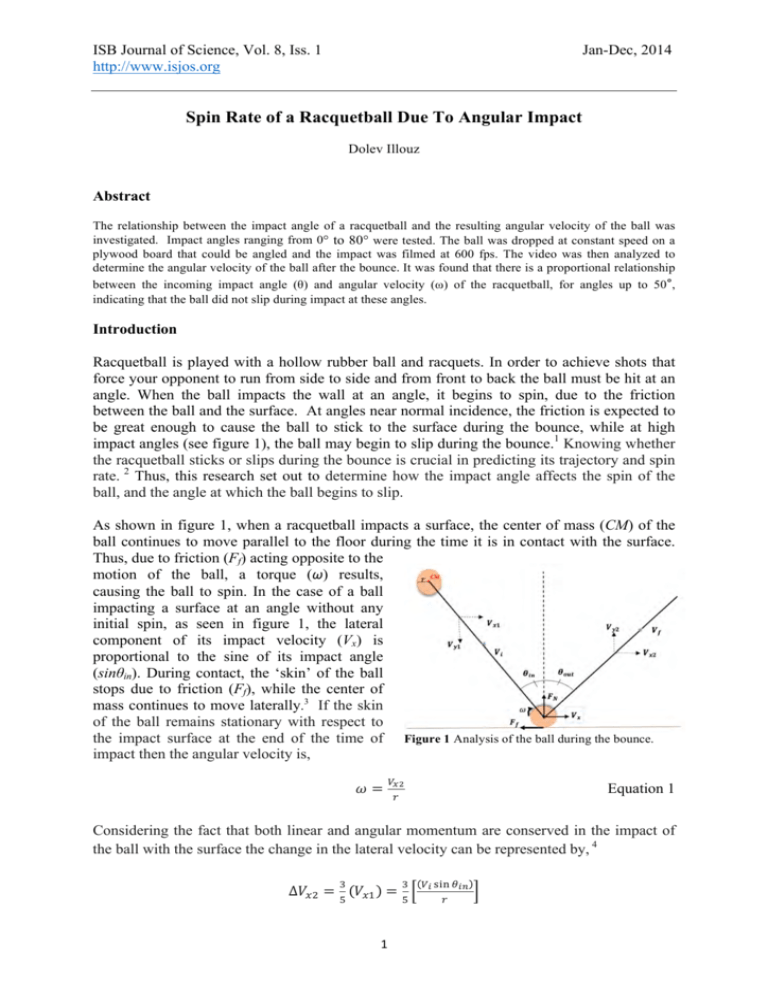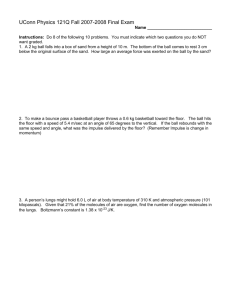
ISB Journal of Science, Vol. 8, Iss. 1
http://www.isjos.org
Jan-Dec, 2014
Spin Rate of a Racquetball Due To Angular Impact
Dolev Illouz
Abstract
The relationship between the impact angle of a racquetball and the resulting angular velocity of the ball was
investigated. Impact angles ranging from 0° to 80° were tested. The ball was dropped at constant speed on a
plywood board that could be angled and the impact was filmed at 600 fps. The video was then analyzed to
determine the angular velocity of the ball after the bounce. It was found that there is a proportional relationship
between the incoming impact angle (θ) and angular velocity (ω) of the racquetball, for angles up to 50°,
indicating that the ball did not slip during impact at these angles.
Introduction
Racquetball is played with a hollow rubber ball and racquets. In order to achieve shots that
force your opponent to run from side to side and from front to back the ball must be hit at an
angle. When the ball impacts the wall at an angle, it begins to spin, due to the friction
between the ball and the surface. At angles near normal incidence, the friction is expected to
be great enough to cause the ball to stick to the surface during the bounce, while at high
impact angles (see figure 1), the ball may begin to slip during the bounce.1 Knowing whether
the racquetball sticks or slips during the bounce is crucial in predicting its trajectory and spin
rate. 2 Thus, this research set out to determine how the impact angle affects the spin of the
ball, and the angle at which the ball begins to slip.
As shown in figure 1, when a racquetball impacts a surface, the center of mass (CM) of the
ball continues to move parallel to the floor during the time it is in contact with the surface.
Thus, due to friction (Ff) acting opposite to the
motion of the ball, a torque (ω) results,
causing the ball to spin. In the case of a ball
impacting a surface at an angle without any
initial spin, as seen in figure 1, the lateral
component of its impact velocity (Vx) is
proportional to the sine of its impact angle
(sinθin). During contact, the ‘skin’ of the ball
stops due to friction (Ff), while the center of
mass continues to move laterally.3 If the skin
of the ball remains stationary with respect to
the impact surface at the end of the time of Figure 1 Analysis of the ball during the bounce.
impact then the angular velocity is,
𝜔=
!!!
Equation 1
!
Considering the fact that both linear and angular momentum are conserved in the impact of
the ball with the surface the change in the lateral velocity can be represented by, 4
∆𝑉!! =
!
!
𝑉!! =
1 !
!! !"# !!"
!
!
ISB Journal of Science, Vol. 8, Iss. 1
http://www.isjos.org
Jan-Dec, 2014
Therefore,
𝜔=
! (!! !"# !!" )
!
!
,
Equation 2
As long as the ball does not slip on the impact surface. At low impact angles (close to
perpendicular), the frictional force between the surface and the skin of the ball is expected to
be great enough to cause the ball to stick to the surface during the bounce, and equation 2
applies.5 However, at greater impact angles, the force required to get the ball spinning at 𝜔 is
expected to exceed the maximum frictional force, and the ball will slip during the bounce.3
This will reduce its spin rate and increase the horizontal component of its bounce velocity
(𝑣!! ), which will result in a change in its bounce trajectory.
In this research, the impact angle at which slippage occurs will be determined for a
racquetball being dropped from a fixed height onto an inclinable surface at different angles.
As described above, the point of slippage for a racquetball is expected to occur at impact
angles where the force needed to accelerate the ball up to the expected angular velocity
exceeds the maximum frictional force. Determining this angle will enable racquetball players
to understand and predict the trajectory of the ball at all impact angles.
Methods
An inclined plane was adjusted to angles ranging from 0° to 80°, using wooden wedges. A
regulation racquetball was marked similar in fashion to a basketball as show in figure 2,
allowing the ball to be tracked
in a data analysis program. The
ball was placed at a fixed drop
height (70.3± .1 cm) above a
predetermined impact point
prior to every trial. A highspeed camera was set up such
that it was perpendicular to the
drop path of the ball and
spotlights were used to
illuminate the setup. With the
experimental setup in place, the
ball was released and its impact
filmed at 600 frames per
second. This process was
repeated for 8 different angles Figure 2 The experimental setup used.
ranging from 0° to 80°.
As seen in figure 3 below, the angular velocity of the ball was calculated by tracking the ball
in a video analysis program. In figure 3a, two points were placed on each end of the
equatorial line on the ball at impact. An additional two points were placed on the ball after
10 frames had passed, as shown in figure 3b, the second image. Finally, the angle created at
the point of intersection, seen in figure 3c, is the angular displacement of the ball within the
time of the 10 frames, which was used to calculate the angular velocity of the ball.
2 ISB Journal of Science, Vol. 8, Iss. 1
http://www.isjos.org
Jan-Dec, 2014
Figures 3a, 3b, 3c The video was analysed to determine the angular velocity of the ball after impact.
Results and Discussion
As seen in figure 4, the relationship
between the impact angle and the angular
velocity of the racquetball is proportional
up to 50°. At an impact angle of 60° the
racquetball begins to slip, and by 80°,
significant slipping is occurring, as the spin
rate is significantly lower than expected.
The relationship between spin rate and sine
of the impact angle can be expressed as,
𝜔 = 81 ±10 𝑠 !! sin 𝜃.
Equation 5
Using the impact velocity and the radius of
the racquetball in equation 2 resulted in a
predicted proportionality constant of 80 s-1.
This matches the results shown in equation
5, and strongly supports the conclusion that
the racquet ball skin is gripping the surface
at impact angles up to 50°.
Figure 4 The proportional relationship between impact
angle and the angular velocity of a ball with a
proportionality constant of 81. Above 50° the ball
begins to slip during impact.
Since in practical play the ball very rarely impacts at an angle above 60°, it seems that it
would be realistic for a player to assume that the ball will always stick and that the ball’s spin
and its bounce trajectory will follow a predictable pattern. But, as can be seen from figure 4,
even if the ball impacts at an angle of 80°, there is a reduction in spin of only around 10%,
implying that the effect on the trajectory will be minimal.
There were several aspects of this research that reduce the confidence with which the
conclusions can be applied to practical racquetball play. Firstly, the surface used was wood,
which does not have the same friction coefficient as a normal court. Another issue was that
rather than the ball being launched at different angles onto a horizontal surface, the ball was
dropped onto a surface that was inclined to the different angles. Finally, the constant speed
of impact studied was much lower than the range of speeds experienced in typical play. Thus,
3 ISB Journal of Science, Vol. 8, Iss. 1
http://www.isjos.org
Jan-Dec, 2014
it is possible that the conclusions of this research may not correctly model the behavior of a
racquetball during normal play.
It is suggested that methods be developed to study the impact behavior of a racquetball under
typical playing conditions. This might be done using a variable-speed ball launcher to project
balls at various angles onto a racquetball court floor and walls. It is suggested that further
testing of angles between 50° and 80° be conducted, so that the point of slippage can be more
precisely determined. Finally, further research using a force plate and a high speed camera for
a ball striking a vertical plane may lead to a better understanding of the dynamics of the ball
during impact.
Conclusion
It has been shown that when a racquetball impacts a surface at an angle of 50° or less, the
skin of the ball sticks to the surface during impact, resulting in a proportional relationship
between the sine of the impact angle and the resulting spin rate of the ball. At impact angles
above 50°, the ball begins to slip, resulting in reduced slipping and an altered trajectory.
Since the ball rarely impacts above 60° during normal play, a racquetball player can generally
assume that the spin rate and bounce trajectory will be that predicted for a non-slipping
impact, and adjust his play accordingly.
References
1
Cross, Rod. "Grip-slip Behavior of a Bouncing Ball." American Journal of
Physics 70(11), 1093-101.
2
Cross, Rod. (2015). Bounce of a spinning ball near normal incidence. American Journal
of Physics, 73(10), 914-920.
3
Hull, Derek, and D. J. Bacon. Introduction to Dislocations. 4th ed. Oxford: ButterworthHeinemann, 2001.
4
Halliday, David, Robert Resnick, and Jearl Walker. Fundamentals of Physics. Hoboken,
NJ: Wiley, 2005.
5
Hibbeler, Russell C. (2009). Engineering Mechanics, pp. 314, 153. Upper Saddle River,
New Jersey: Pearson Prentice Hall.
4









